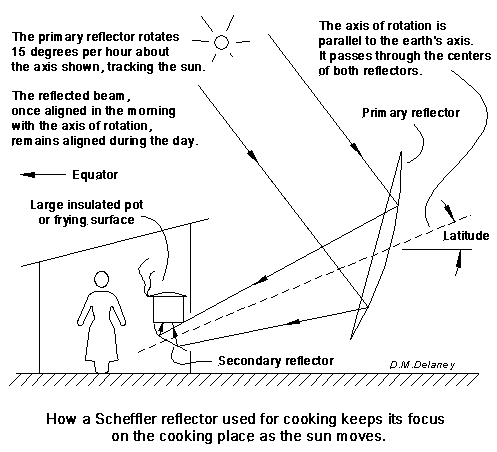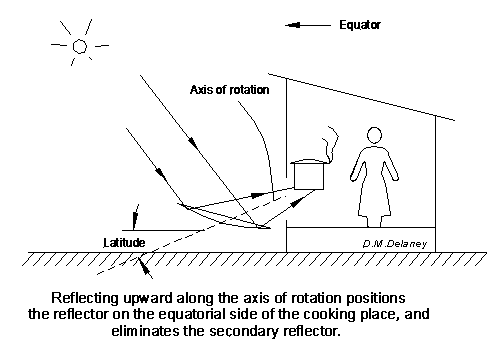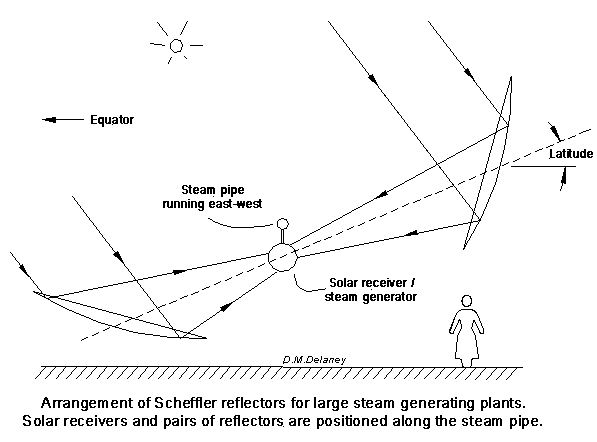wikia
http://solarcooking.wikia.com/wiki/Scheffler_Community_Kitchen
http://davidmdelaney.com/scheffler-precis/scheffler-precis.html
Scheffler Community Kitchen
Author: David Delaney, Ottawa
June 15, 2000. Revised February 1, 2003
Revised and expanded, February 22, 2009.
Wolfgang Scheffler is the inventor/promoter of the Scheffler Community Kitchen--community kitchens and bakeries that use large parabolic dishes that provide the heat for cooking large quantities of food in an indoor kitchen. Over 750 large cookers have been built distributed worldwide by early 2004. Wolfgang Scheffler was the recipient of a Special Recognition Award at the 2006 Nuclear-Free Future Awards ceremony, held at the Navajo Education Center on December 1, 2006
Wolfgang Sheffler and his colleagues have installed solar reflectors to provide cooking heat in many community kitchens since 1986, mostly in India.[1] [2] The concentrating reflectors track the movement of the sun, reflecting the light of the sun and concentrating it on a fixed position.[3] In some configurations the reflected and concentrated sunlight enters a nearby kitchen directly to strike a cooking pot or frying surface.[4] In other configurations, the concentrated sunlight is used first to create steam[5] which is transported by pipes to a nearby kitchen.

A heliostat is a device that reflects sunlight in a fixed direction as the sun moves. Scheffler's heliostat[2] has a concentrating reflector turned by a clockwork powered by gravity or photovoltaic panels. The rotating reflector produces a converging beam of sunlight aligned with its axis of rotation, which is parallel to the axis of the earth. The converging beam of reflected sunlight enters the kitchen through a hole in its wall. When the rotating reflector (in this case the primary reflector) is placed on the polar side of the kitchen, a fixed secondary reflector inside the kitchen redirects the beam upward to the bottom of a pot or frying surface. The rotating reflector turns at a rate of one revolution per day (15 degrees per hour) to keep the reflected beam aligned with the axis of rotation as the sun moves.
Each morning, the operator rotates the concentrating reflector back to a starting position in which the reflected beam is aligned with the axis of rotation of the reflector, and starts the clockwork mechanism. Every few days the operator adjusts the angle between the axis of rotation and the concentrating reflector to accommodate the seasonal variation in the height of the sun. once the reflected beam is aligned with the axis of rotation of the concentrating reflector and the clockwork is in motion, the reflected beam remains aligned with the axis of rotation all day.
The shape of the concentrating reflector approximates an off-axis section of a paraboloid. The seasonal variation in the height of the sun requires changing not only the angle between the concentrating reflector and its axis of rotation, but also the shape of the reflector.[6] The geometry of the framework supporting the reflecting surface is designed so that the action of changing the angle between the concentrating reflector and its axis of rotation stretches or squeezes the horizontal dimension of the concentrating reflector to flatten it or to make it more dished.
The reflecting surface of the concentrating reflector consists of a number of facets, usually flat glass mirrors. A concrete pad and a welded steel space frame provide support for the concentrating reflector. The area of the concentrating reflectors in the configurations shown above is usually about 10 square meters, delivering approximately 2 kW to the cooking pot or solar receiver.
The reflector may be positioned on the equatorial side of the kitchen. From this position, reflected sunlight travels upward along the axis of rotation, eliminating the need for a secondary reflector.

Scheffler reflectors have been used to make steam for solar steam kitchens in India.[5] The Tirumala temple in the south Indian city of Tirupathithat, [7] for example, uses many Scheffler reflectors to make steam for cooking in a nearby kitchen. In solar steam kitchens, concentrating reflectors are arranged on both the equatorial and polar sides of solar receivers attached to the steam pipes that transport the steam to the kichen.

At least one heat storage system for deferred cooking has been deployed with a Scheffler reflector.[8] The heat store consisted of an iron mass in an insulated container. one end of the iron mass was exposed to the focus of the heliostat during the day, then capped with an insulated lid to save the collected heat for cooking or frying up to 24 hours later.
Reference
- ↑ Biographical note on Wolfgang Scheffler, Retrieved on 2009-2-24.
- ↑ 2.0 2.1 Solare Bruecke ,Scheffler's web site.
- ↑ Scheffler Community Parabolic Solar Cooker,Ghadia Solar's overview
- ↑ First Solar Community Kitchen in Nepal Photographs of the interior of the cooking shed of a Scheffler solar kitchen
- ↑ 5.0 5.1 Steam cooking system, Ghadia Solar Energy Systems.
- ↑ The Scheffler Reflector Describes the geometry of the support that squeezes or stretches the reflector.
- ↑ India's Temples Go Green Time magazine, July 7, 2008.
- ↑ Installation of a heat storage system at the Baha'i Vocational Institute for Rural Women. Good photos of reflector frames, mounts, clockwork mechanism, and heat storage system.
'삶의 이야기 > 난방 로켓스토브' 카테고리의 다른 글
| [스크랩] 원리2 (0) | 2011.10.19 |
|---|---|
| [스크랩] 로켓스토브 원리 (0) | 2011.10.19 |
| [스크랩] 온돌, 구들 (0) | 2011.03.04 |
| [스크랩] 향유네 삶터짓기 (9) 벽난로 구들방 놓기 (향유네집) (0) | 2009.10.07 |
| [스크랩] 로켓스토브 각 부위 치수와 비율 (0) | 2009.09.10 |
